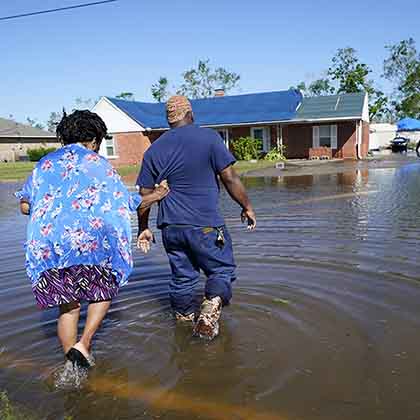Chapter 1
Weathering the Storm
Impact of climate change lingers after a devastating year in Louisiana
Lake Charles, La. A pot lid. A beat-up Nintendo controller. A headless figurine. Nearly a year after Hurricane Laura hit southwest Louisiana, Clair Marceaux could still pick bits and pieces of her family’s lives out of the feral lawn surrounding the concrete slab where her house once stood.
The storm crashed ashore near her home in Cameron, Louisiana, on August 27, 2020, just shy of Category 5 strength. More than 4.5 meters (15 feet) of storm surge sheared her house off the slab and carried it away. When her family returned to survey the damage, nothing remained but rubble.
“My husband just kept stacking up cinder blocks because what else are you going to do?” Marceaux said. “It’s not like you have anything to repair. It’s just like (the house) was never there.”
Louisiana is facing climate threats both acute and chronic, from the battering of more intense storms to the creeping erosion of rising sea levels. State demographic data are already showing people leaving the coast for higher ground. The state government considers climate change an existential threat to many of its communities.
Natural disasters brought on by climate change are forcing people from their homes from Central America to Southeast Asia. The United States is no exception.
As part of an in-depth exploration of climate migration worldwide, VOA traveled to Louisiana to document the impacts of a devastating year of natural disasters on the state’s Gulf of Mexico coast.
Marceaux used to watch the marsh birds from her porch less than 3 kilometers (2 miles) from the Gulf, savoring her morning coffee and the smells of breakfast cooking. A year after the storm, the memories still choked her up.
“It’s traumatic to come here. It’s traumatic to talk about it,” she said.
Marceaux is the port director for Cameron Parish, the county home to the largest liquefied natural gas export facilities in the United States. To show VOA journalists around in the August heat, she swapped business attire for jeans and a T-shirt that read “Lâche Pas” – Cajun for “don’t give up.”

Buildings and homes are flooded in the aftermath of Hurricane Laura, Thursday, Aug. 27, 2020, near Lake Charles, La.
Buildings and homes are flooded in the aftermath of Hurricane Laura, Thursday, Aug. 27, 2020, near Lake Charles, La.

Soncia King holds onto her husband, Patrick King, in Lake Charles, La., Saturday, Oct. 10, 2020, as they walk through the flooded street to their home, after Hurricane Delta moved through. (Gerald Herbert | AP)

Clair Marceaux lost her home in Cameron, La., to Hurricane Laura in 2020. (VOA News)
LEFT: Soncia King holds onto her husband, Patrick King, in Lake Charles, La., Saturday, Oct. 10, 2020, as they walk through the flooded street to their home, after Hurricane Delta moved through. (Gerald Herbert | AP) RIGHT: Clair Marceaux lost her home in Cameron, La., to Hurricane Laura in 2020. (VOA News)
Year of devastation
With sustained winds of 240 kilometers per hour (150 mph), Laura was the strongest hurricane on record to hit Louisiana since 1856. (Hurricane Ida tied that record this year.)
But the storm that wiped away Marceaux’s home was not even a hurricane two days earlier. Laura exploded from a tropical storm to a hurricane pushing the upper limit of Category 4 in just 36 hours as it passed over the warm waters of the Gulf of Mexico.

Hurricane Laura made landfall on Aug. 27, 2020. (NOAA)
Attributing any individual weather event to climate change is a challenge. There has been severe weather since the dawn of time without human influence. Hurricanes happen, especially in Louisiana.
But researchers say global warming is “loading the dice” in favor of more extremes. Warmer waters are raising the odds that a storm will undergo the kind of rapid intensification that Laura did. And increasing ocean temperatures are making stronger hurricanes more likely.
Hurricane Laura inflicted $19 billion in damage across the region.
But there was more to come.
Three more major weather disasters would strike southwest Louisiana over the next nine months. Hurricane Delta hit just six weeks after Laura. A freakish Arctic blast in February burst pipes across town. And a 30-centimeter (1-foot) deluge on one day in May triggered another round of heavy flooding.
Experts note that the warming atmosphere holds more water, which is leading to heavier rainstorms and rainier hurricanes. And there is evidence – though not conclusive – that melting Arctic sea ice is affecting polar wind patterns and allowing frigid air to wander south. That may be bringing extreme cold to unexpected places more often.
 Nic Hunter
Lake Charles mayor
Nic Hunter
Lake Charles mayor
“If you asked me about climate change 10 years ago, I probably would have said I think that’s a bunch of hogwash or some type of made-up agenda,” said Lake Charles Mayor Nic Hunter. “I don’t believe that today.”
While Hunter does not expect that Lake Charles will be hit with multiple major climate disasters every year, “certainly we would be foolish to think that we would never see events like that again,” he said.
The cascading impacts of the repeated weather disasters extend far beyond the shredded roofs, flooded homes and wrecked buildings. They are affecting the economy of southwest Louisiana long after the storms have passed.
The lingering effects demonstrate how climate change is about more than just extreme weather. Its impacts ripple through society.
In southwest Louisiana, the extensive damage has left many residents without homes and many employers without workers.

Steamboat Bill's, a popular Lake Charles seafood restaurant, is operating with less than half its usual staff, according to owner Kathi Vidrine. (VOA News)
‘Want a job here?’
The lunchtime crowd streamed into Steamboat Bill’s, a popular crawfish shack in Lake Charles, Louisiana, 48 km (30 miles) north of Cameron. The decor is Cajun kitsch at the restaurant, located just over the Calcasieu River Bridge from the Phillips 66 oil refinery. A stuffed alligator dangles from the ceiling with Mardi Gras beads around its neck. Sculptures of zydeco musicians hang on the walls.
Waitresses carried mounds of fried Gulf shrimp and bowls of crawfish étouffée.
“Everything’s local. Comes from Louisiana,” said owner Kathi Vidrine.
With spiky red hair, sparkling eyes and an accent that betrayed her Chicago roots, Vidrine worked the room, chatting with customers and friends.
“You want a job here?” she asked a 16-year-old customer.
Vidrine was not just making conversation. She really needed the help.

Owner Kathi Vidrine replaced the roof twice at her restaurant, Steamboat Bill's, after Hurricanes Laura and Delta. (VOA News)
Steamboat Bill’s was still suffering the effects of a year of repeated weather disasters when VOA visited in August.
Roof damage from Hurricane Laura had led to water damage inside. Vidrine had fixed that damage. But six weeks after Laura, Hurricane Delta “took off the roof that we just put on,” she said. “So, we started all over again. So, that was crazy.”
But the bigger problem has been finding workers.
The restaurant has been running short-staffed and has cut its hours since it reopened in March. It takes about 50 people to run Steamboat Bill’s, Vidrine said. “I need about 30 more people. I’ve got 20, and all my family (are) working.”
She blamed the shortage on the extra federal unemployment benefits offered because of the pandemic, though a study found that ending those benefits early did not drive many people back to work.
The other reason, Vidrine acknowledged, is because it has gotten much harder for workers to find a place to live.
“I had two people who lost their houses. One is living with the parents,” she said. “There are so many (people) that have moved away.”
“There’s so many destroyed buildings in this town, and the ones that aren’t destroyed are condemned,” she added.
The Capital One Tower, severely damaged in Hurricane Laura, remains abandoned more than a year later. (VOA News)
Gateway to the city, destroyed
From a distance, the mirrored turquoise sheen of the 22-story Capital One Tower dominates the skyline of the lakefront business district in Lake Charles. Up close, however, the building is covered with almost as much plywood as glass.
“It’s like our gateway to the city,” said Becky Franks, marketing manager at staffing firm Manpower. The company had its offices on the 15th floor. It was overwhelming to see “such a massive structure, you know, just destroyed,” she said.
The local chamber of commerce got Franks and her colleagues temporary offices in the chamber’s building. But filling jobs for their clients has been harder.
“There just aren’t enough workers. And you see that down every street with every business,” she said.
The labor shortage is not unique to Lake Charles. Businesses across the country are having a hard time filling jobs since the COVID-19 pandemic rearranged people’s work lives.
But U.S. Bureau of Labor Statistics data show that the situation is worse in Lake Charles.
At the depth of the crunch in April 2020, the number of nonfarm employees across the state of Louisiana shrank to 85% of its pre-pandemic size. The city of Lake Charles took a similar hit.
Storms Add to, Prolong Lake Charles Pandemic Workforce Losses
Percentage change of workers compared to February 2020
Sources: Federal Reserve Bank of St. Louis
But in August, as the rest of the state recovered, the destruction of Hurricane Laura knocked Lake Charles’ workforce down further. And the repeated storms kept it down. A year after Laura, while the state workforce was back to 93% of its pre-pandemic levels, Lake Charles’ employee rolls were still down at 84%.
“It’s because they’re not here. It’s because they don’t have a place to live,” Franks said. “That’s been a huge struggle.”

Blue tarps cover damaged roofs in the Lake Charles neighborhood of Greinwich Terrace. (VOA News)
‘The largest hurdle’
Blue tarps outnumber shingled roofs in the mainly low-income, African American neighborhood of Greinwich Terrace. Those tarps cover roofs damaged in the storms that still have not been repaired a year after Hurricane Laura.
Joyce Nash fared better than many of her neighbors. The high school custodian said that the water came up to her windows in the last flood, but the house is still habitable after a year of devastating storms.
“My neighbors aren’t able to come back because their home isn’t livable,” she said. “They want to come back, but they can’t…because of the horrible conditions.”

Joyce Nash (seated) lives on a Greinwich Terrace street lined with abandoned houses. (VOA News)
The streets are lined with abandoned houses. One neighbor is living in a home that Nash doubts should be lived in. But there are not many options.
“If you try to move and go somewhere else, where we got to go? We have nowhere to go because the rent is so high,” Nash said. “They have no homes here for us to move (to).”
Mayor Hunter acknowledges the problem. Housing is “by far the largest hurdle that we have to recovery,” he said.
Hurricanes Laura and Delta damaged nearly half of the residential buildings in Calcasieu Parish, where Lake Charles is located, according to a November 2020 analysis by the consulting firm McKinsey & Company. More than a quarter sustained major damage or were destroyed. And that does not include the effects of the winter freeze or the spring flood.
The city government estimates that housing damage adds up to $235 million. Out of a population of nearly 80,000, Hunter told VOA that 5,000 to 7,000 people are still displaced. Enrollment in the parish or county school district was down by 14% at the beginning of the school year.
Resilience challenged
“Louisiana people tend to see themselves as resilient,” said Craig Colten, Louisiana State University emeritus professor of geography and anthropology. They see dealing with disasters as like going to the gym: “The more hurricanes you endure, the stronger you are,” he said. “But psychologists, of course, don’t tend to agree with that.”
 Craig Colten
Professor of geography and anthropology
Craig Colten
Professor of geography and anthropology
“Each time a storm hits, it drives the resilience of the population further down, and they have farther to go to get out of the depressed state of the economy and their social well-being,” Colten said.
That does not bode well for southwestern Louisiana in a future in which climate change brings more severe and more frequent storms, he said.
“Each time there’s a big event, the population will decline a bit,” Colten predicted. “They’ll become shrinking cities over the long term.”
New Orleans saw its population plunge after Hurricane Katrina, he noted, and it has not fully recovered 16 years later.
The impacts can be even greater outside the big cities, he added. Once the population drops below a certain point, “they shut down your post office. You can’t support the grocery store. You can’t support the schools. … There might be a tipping point, and everybody begins to head inland.”
That process may already be under way in Cameron.
Only 9,500 people lived in the entire parish before Hurricane Rita hit in 2005. After the storm, the population dropped by about 2,000. It had not recovered much before Laura hit. It’s not clear how many have left this time, but port director Marceaux expects the population to drop further.
“We used to have a movie theater here when I was a little kid. We had clothing stores. We had all the amenities any small town needs,” she said. “And those things simply haven’t come back since Hurricane Rita. Even more of them were destroyed (in) Hurricanes Laura and Delta.”
She and her family are staying. Her and her husband’s jobs are here, and her daughter is in high school. They bought a damaged house from a neighbor who has moved away. The family is living in a recreational vehicle until the repairs are done.
She recognizes that the situation is becoming more precarious as the climate changes. But this is home.

The concrete slab is all that remains of Clair Marceaux's home after Hurricane Laura. (VOA News)
“I never did really understand why outsiders want to know, ‘Why do you want to live here?’ Well, why did they want to live where they live?” she asked.
“No one is immune to natural disasters. … It’s not a situation where just because someone lives in North Dakota or Wyoming or somewhere in Europe or Asia or any other continent, they’re going to escape it.
“We’re not going to be climate refugees. I mean, I guess we already are in some ways.
“But I think it’s a question that everyone in the world needs to be asking. Not just us.”